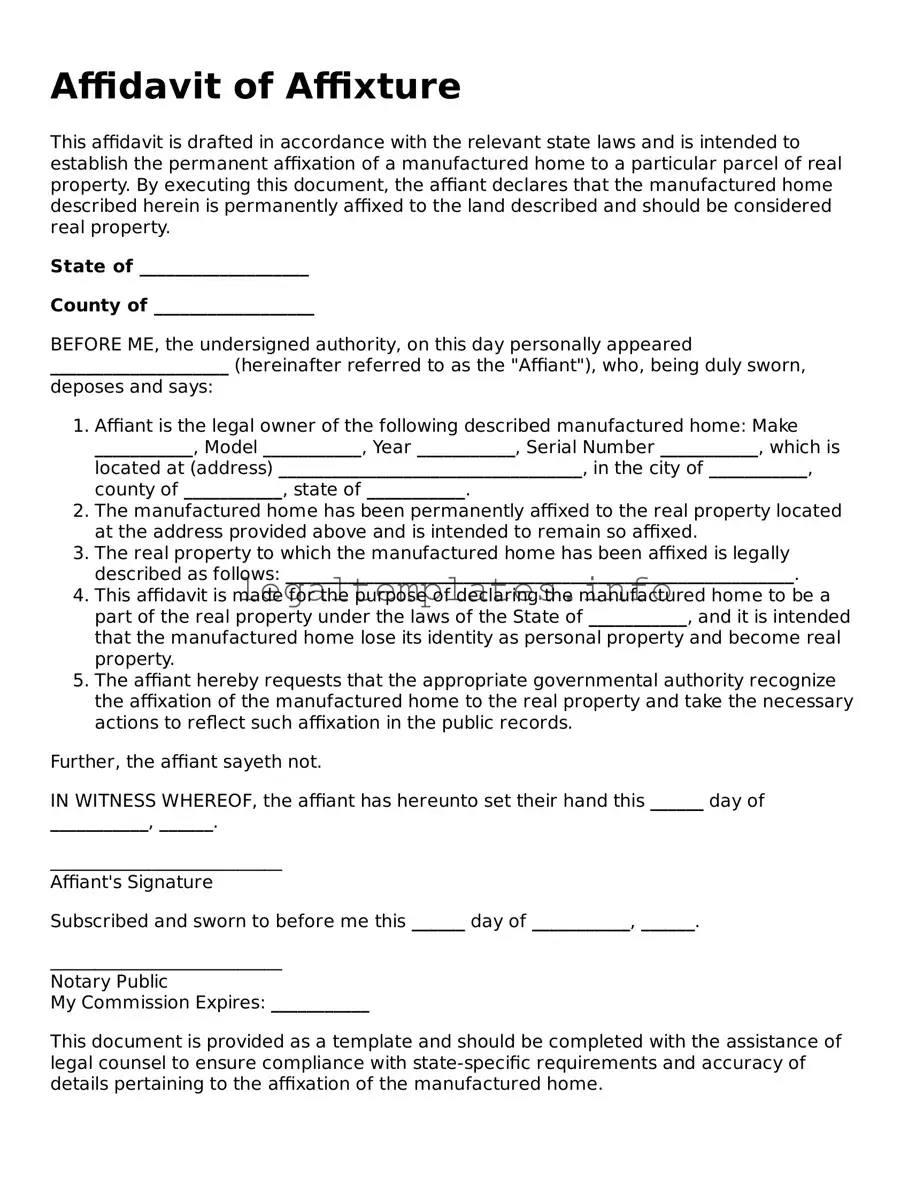What is an Affidavit of Affixture?
An Affidavit of Affixture is a legal document used to declare that a mobile home or manufactured housing unit is permanently attached to land. This effectively transforms the property status from personal property to real estate, which can significantly impact the rights of the owner, including taxation, financing options, and selling procedures.
Why would I need an Affidavit of Affixture?
If you own a mobile home and want to ensure it is taxed as real estate instead of personal property or if you wish to secure financing similar to a mortgage, you might need an Affidavit of Affixture. This document is crucial in jurisdictions that require a mobile home to be affixed to land for it to be considered real estate, impacting both the value and the legal treatment of the property.
How do I prepare an Affidavit of Affixture?
Preparing an Affidavit of Affixture typically involves completing a form provided by the local government or a legal template that meets your jurisdiction's requirements. This includes details about the mobile home, such as make, model, and serial number, and information about the land it is affixed to. It may also require a declaration of permanent attachment, including how the home is affixed to the land and evidence of such attachment.
What information is required in an Affidavit of Affixture?
The exact information required can vary by jurisdiction but generally includes the homeowner's name, a description of the mobile home (make, model, year, and serial number), the address or legal description of the land, and a statement of the home's permanent affixation to the land. It often requires notarization and possibly the landowner's consent if different from the mobile home owner.
Where do I file an Affidavit of Affixture?
An Affidavit of Affixture is typically filed with the county recorder's office or a similar local government entity responsible for land records. Filing this document officially records the affixture, changing the status of the property to real estate in public records.
How does an Affidavit of Affixture affect my taxes?
By converting a mobile home from personal property to real estate through affixation, the property might now be subject to property taxes rather than personal property taxes, which could be lower or higher, depending on local tax rates and assessments. This conversion could also affect eligibility for certain property tax exemptions and deductions.
Can an Affidavit of Affixture be reversed?
Reversing an Affidavit of Affixture, turning real estate back into personal property, is typically complex and may not be possible in all jurisdictions. It usually involves legal proceedings, and the specific requirements can vary greatly depending on local laws. It is important to consider the permanence of affixation before proceeding.
Does an Affidavit of Affixture affect selling my home?
Yes, having an Affidavit of Affixture can affect the selling process. Mobile homes classified as real estate can often be sold in a manner similar to traditional homes, potentially attracting a broader range of buyers and financing options. It also typically involves a deed transfer rather than a title transfer characteristic of personal property.
Who can sign an Affidavit of Affixture?
The homeowner, as the property owner of the mobile home and possibly the land, is usually required to sign the Affidavit of Affixture. If the land is owned by a different party, their approval and signature may also be necessary. All signatures must typically be notarized to validate the document.
Is an attorney required to prepare an Affidavit of Affixture?
While an attorney is not always required to prepare an Affidavit of Affixture, consulting with one can be beneficial, especially in complex situations or when specific legal advice is needed. An attorney can ensure that the document meets all local legal requirements and properly reflects the affixation of the home to land.
